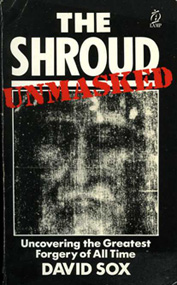
 |
Since 1898, the Shroud has been scrutinised by specialists from photographers through historians, pollen analysts, textile experts, art historians, and astronautical scientists, to radiocarbon physicists. Sox writes a very informative account of all this research and its results, outlining the arguments for and against the Shroud's authenticity. The Bible reports that Christ's body was wrapped in a linen cloth, and the anatomical accuracy of the man's image is considered to be atypical of fourteenth century painting. That the image looks like a photographic negative seems to bear this out. Also, the lash marks all over the figure's body are similar to what would have been made by the lead or bone tips of a typical Roman whip of the first century A.D. Most importantly, scientific testing in the 1970s remained inconclusive.
Against the relic's authenticity, there are no documentary references to the Shroud before 1356. The "bloodstains" also remained red and had not blurred when they came into contact with the cloth. The limbs seem too long, while the genitals and the buttocks are unclear - "artistic modesty" on the part of a forger was suggested. According to Jewish custom, a person's face was not covered by cloth after death, and no twill linen (such as the Shroud) has been found dating to the first century A.D. in Palestine or Egypt.
Research in the 1970s produced ambiguous results. Pollen found on the Shroud included those from four plant genuses that exist in Israel, but these also grow in Italy (though as different species). There was a high level of iron oxides for the "bloodstains" but x-ray analysis indicated that they were consistent with actual blood. When a VP-8 Image Analyser was used to clarify the Shroud's image (as it had done for photographs of the planet Mars), it indicated that the figure was created by the cloth coming into contact with a human body. However, it had been pointed out that such results can be programmed into a computer, so the evidence of the Analyser was not conclusive.
Sox is especially good on the politics regarding the treatment of the Shroud, as he was involved in them himself. But, as a result, his own biases come across. For example, he is not fond of Luigi Gonella, the Turin polytechnic professor who helped delay the radiocarbon dating of the Shroud - seen by many as the ultimate test of the relic's authenticity. Sox could not help taking a jibe at the professor when he mentioned the latter's fear of flying (p.120). Giving the age of Dr Susan Trumbone was equally irrelevant.
His discussion of dendrochronology as a method of dating ancient artifacts (pp.80-81) is simplistic in that he does not point out how regional factors, such as climate, can produce variations in tree growth. This means that contemporaneous tree-rings from two different climatic regions will not necessarily match up. For example, ship's timbers dating to the Viking era that were found on archaeological excavations in Dublin, Ireland, differed from the Irish tree-ring chronology for that period. The ship was later found to have been built in Scandinavia (Jermy, 1990)!
The book itself is in dire need of an index as well as a glossary of people's names - the number of scientists working on the Shroud is incredible for just one object! The type-setting also leaves something to be desired - some sentences do not even begin with a capital letter (e.g. on p.77)!
The worst aspect of the book is that Sox never gives us the specific dates that were obtained by three radiocarbon labs. On page 151, he tells us that 'the Arizona test did not show the shroud was 2000 years old', and that this verdict was confirmed by the Zurich lab three weeks later. What of Oxford's test? Sox simply concludes that the date was "medieval" and that '[n]ow with a cold date in front of us, most of the extraordinary enthusiasm generated toward the Shroud, looks more than a little silly'. Indeed! The radiocarbon evidence was subsequently revealed to date the shroud to between about 1260 and 1390 A.D. (Anon., 1989).
Ultimately, perhaps, it matters little what science can tell us since many people will continue to believe that the image on the Shroud really is that of Christ whatever the radiocarbon results indicate. In Leonard Chesire's words (p.156): 'I do not believe that you can prove it scientifically or logically, any more than you can give a man faith through a rational argument.' In fact, when the radiocarbon dating results were officially published in February 1989, a Harvard University physicist named Thomas Phillips suggested that the radiocarbon dates could be inaccurate due to the shroud's exposure to a burst of radiation that may have been emitted by the resurrecting body of Christ! Such radiation (if it existed) would probably have interfered with the chemistry of the shroud, thereby producing false readings under the radiocarbon analysis (Anon., 1989).
ANON. (1989) 'Shroud controversy continues', in Evening Echo [Cork], 16 February 1989.
JERMY, Kenneth (1990) 'Salvaged warship revises dates for Viking settlement of Ireland', Minerva 1(8), p. 2.
Back to home page.
visitors to this page since 28 August 1996.
 |
Link added on 6 June 1997; URL updated 13 October 2001; cover picture added 12 April 2006.
The URL for this Web page is http://www.oocities.org/gregory_fewer/shroud.htm
©1991 Thomas G. Fewer
Electronic version © 1996-2009 Thomas G. Fewer